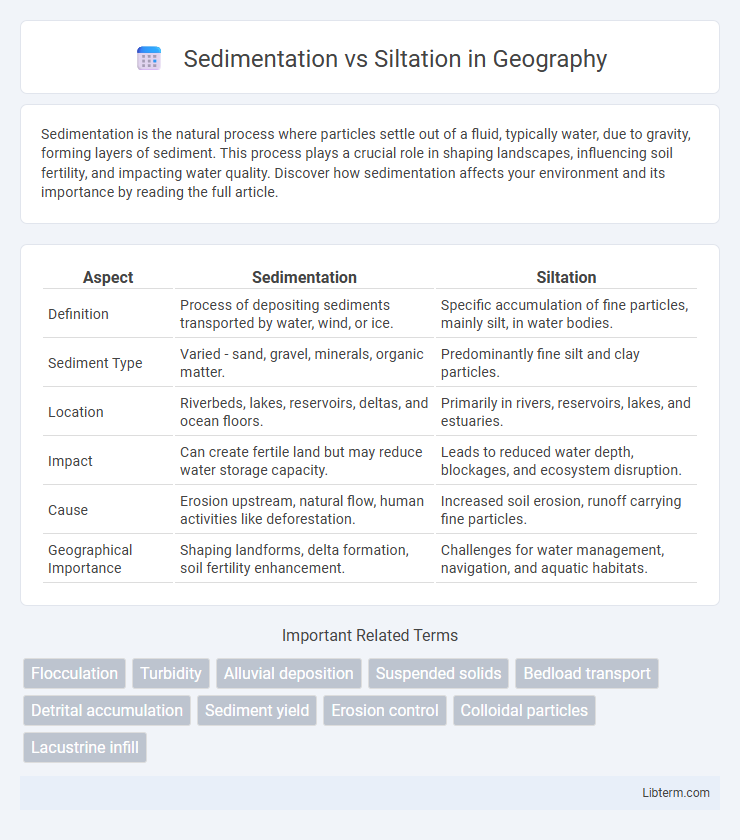Sedimentation is the natural process where particles settle out of a fluid, typically water, due to gravity, forming layers of sediment. This process plays a crucial role in shaping landscapes, influencing soil fertility, and impacting water quality. Discover how sedimentation affects your environment and its importance by reading the full article.
Table of Comparison
| Aspect | Sedimentation | Siltation |
|---|---|---|
| Definition | Process of depositing sediments transported by water, wind, or ice. | Specific accumulation of fine particles, mainly silt, in water bodies. |
| Sediment Type | Varied - sand, gravel, minerals, organic matter. | Predominantly fine silt and clay particles. |
| Location | Riverbeds, lakes, reservoirs, deltas, and ocean floors. | Primarily in rivers, reservoirs, lakes, and estuaries. |
| Impact | Can create fertile land but may reduce water storage capacity. | Leads to reduced water depth, blockages, and ecosystem disruption. |
| Cause | Erosion upstream, natural flow, human activities like deforestation. | Increased soil erosion, runoff carrying fine particles. |
| Geographical Importance | Shaping landforms, delta formation, soil fertility enhancement. | Challenges for water management, navigation, and aquatic habitats. |
Introduction to Sedimentation and Siltation
Sedimentation refers to the natural process where particles such as sand, soil, and minerals settle at the bottom of a water body, forming layers over time. Siltation specifically involves the accumulation of fine particles like silt and clay, often leading to reduced water depth and impacting aquatic ecosystems. Both processes significantly influence reservoirs, rivers, and lakes by altering water flow and storage capacity.
Defining Sedimentation: Processes and Causes
Sedimentation is the natural process where particles like sand, minerals, and organic matter settle out of water or air and accumulate in a specific area, often forming layers. This phenomenon occurs due to the gravitational pull on suspended particles in rivers, lakes, or oceans, influenced by factors such as water velocity, particle size, and watershed characteristics. Causes of sedimentation include soil erosion from deforestation, agricultural activities, and construction, which increase the sediment load transported by runoff into aquatic systems.
Understanding Siltation: Mechanisms and Factors
Siltation is the accumulation of fine soil particles, primarily silt, in water bodies due to soil erosion and runoff from agricultural or construction sites. The process is influenced by factors like rainfall intensity, land slope, vegetation cover, and soil type, which affect the transport and deposition of suspended sediments. Understanding these mechanisms helps in managing sediment loads, preventing waterway blockages, and maintaining aquatic ecosystem health.
Key Differences Between Sedimentation and Siltation
Sedimentation refers to the natural process where particles settle out of water or air and accumulate, forming layers of sediment, whereas siltation specifically involves the excessive accumulation of fine silt particles in water bodies, often due to erosion or human activities. Key differences include sedimentation's broader scope that encompasses varied particle sizes and depositional environments, while siltation focuses mainly on the clogging effect of fine sediments in aquatic systems. Sedimentation can be beneficial for landform building, whereas siltation frequently causes problems like reduced water depth and impaired aquatic habitats.
Environmental Impacts of Sedimentation
Sedimentation leads to the accumulation of particles in water bodies, causing habitat degradation and reducing aquatic biodiversity. It results in decreased water quality by increasing turbidity, which affects photosynthesis and oxygen levels critical for aquatic life. Sedimentation also disrupts fish spawning grounds and can lead to increased flooding risks by altering river and stream flow patterns.
Ecological Consequences of Siltation
Siltation significantly alters aquatic ecosystems by smothering habitats, reducing light penetration, and disrupting photosynthesis critical for aquatic plants and algae. This sediment accumulation decreases oxygen levels, leading to hypoxic conditions that threaten fish populations and biodiversity. Furthermore, siltation can clog fish gills, impair reproduction, and degrade water quality, impacting both wildlife and human water resources.
Human Activities Contributing to Sedimentation and Siltation
Human activities such as deforestation, agriculture, and construction significantly contribute to sedimentation and siltation by accelerating soil erosion and increasing the transport of sediments into water bodies. Urbanization and mining further exacerbate these processes by disturbing land surfaces and creating loose sediment that washes into rivers and reservoirs. Excessive sedimentation and siltation resulting from these activities lead to reduced water quality, habitat degradation, and increased flood risks.
Prevention and Control Methods for Sedimentation
Sedimentation prevention and control primarily involve practices such as effective erosion control, reforestation, and the installation of sediment traps or silt fences to reduce soil particle runoff into water bodies. Implementing contour plowing, maintaining vegetation buffers along waterways, and employing sediment basins help to capture sediments before they enter aquatic systems, preserving water quality and preventing habitat disruption. Regular monitoring and maintenance of these control structures optimize their effectiveness in minimizing sediment accumulation and promoting sustainable land and water management.
Innovative Solutions to Reduce Siltation
Innovative solutions to reduce siltation focus on advanced sediment control technologies like geotextile filters, sediment traps, and bioengineering techniques such as vegetative buffer strips and constructed wetlands to trap and stabilize fine particles before they enter water bodies. Remote sensing and GIS tools enable precise monitoring of sediment loads and land-use changes, facilitating targeted erosion control measures. Integrating these methods with sustainable watershed management practices significantly decreases sediment accumulation, enhancing water quality and reservoir longevity.
Conclusion: Sedimentation vs Siltation—Implications and Future Outlook
Sedimentation and siltation both involve the accumulation of particles, but sedimentation primarily refers to the general settling of particles in water bodies, while siltation specifically denotes the deposition of fine sediments like silt and clay. These processes have significant implications for aquatic ecosystems, water quality, and reservoir capacity, often leading to habitat degradation and increased flood risks. Future outlooks emphasize the importance of sustainable land management practices, sediment control measures, and advanced monitoring technologies to mitigate adverse effects and preserve water resource integrity.
Sedimentation Infographic

 libterm.com
libterm.com